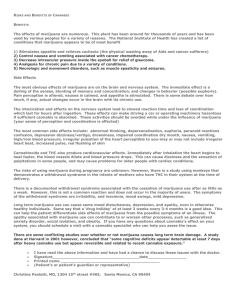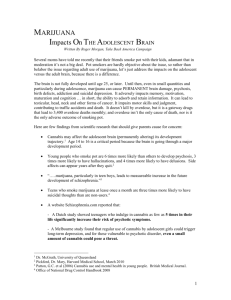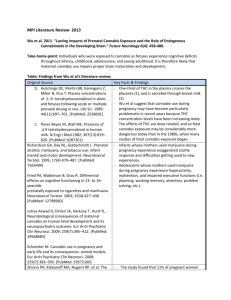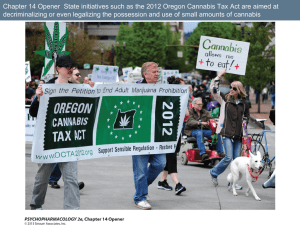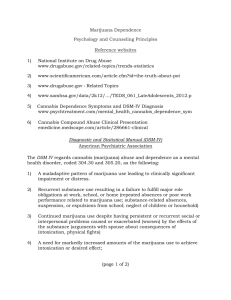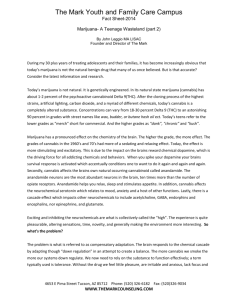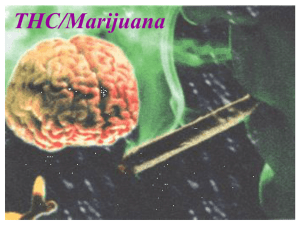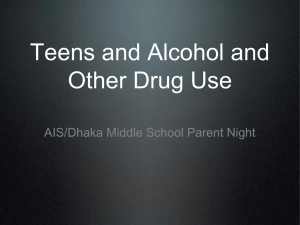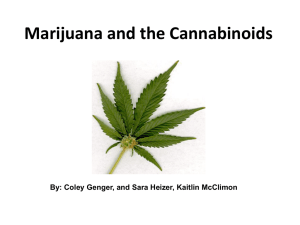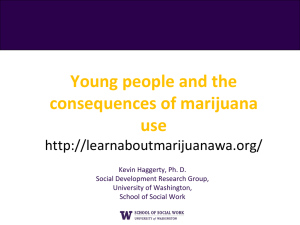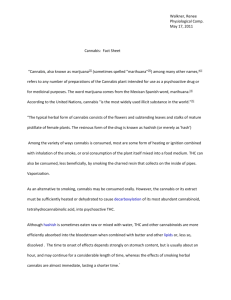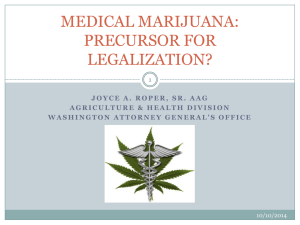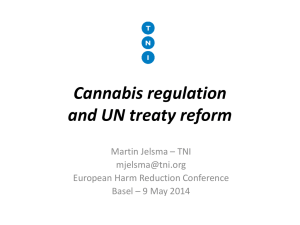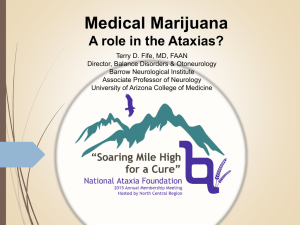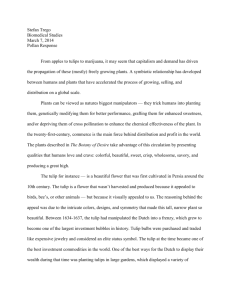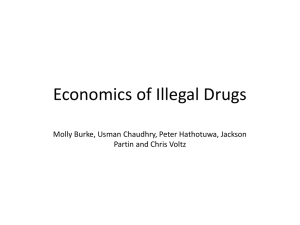Marijuana: Select Effects on Brain, Body and
advertisement
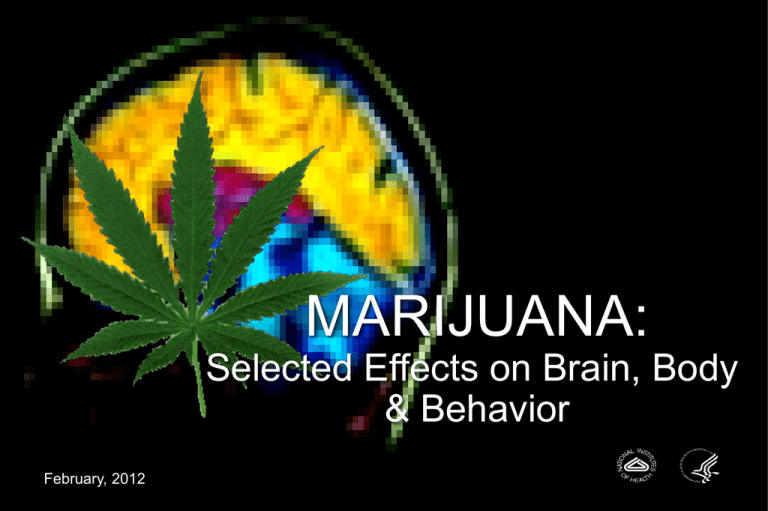
MARIJUANA: Selected Effects on Brain, Body & Behavior February, 2012 Marijuana is the Most Commonly Used Illicit Drug In the U.S. • Over 106 million Americans have tried it at ….least once • An estimated 2.4 million Americans used it for ….the first time in 2010 Tetrahydrocannabinol (THC) Active Ingredient in Marijuana Source: National Survey on Drug Use and Health, SAMHSA, 2010. High Rates of Past Year Dependence or Abuse on Marijuana (Comparison to other Drugs Among Persons 12 or older, 2010) Numbers in Thousands Source: SAMHSA, 2010 NSDUH In 2009, Reports of Past Month Use of Marijuana Among 12th Graders Exceeded that of Cigarette for the First Time in the Survey’s History SOURCE: University of Michigan, 2011 Monitoring the Future Study Changes in Attitude Lead to Changes in Use: Marijuana Use and Perceived Risk in 12th Graders, (1975 to 2010) Past PastYear YearUse use Perceived PerceivedRisk Risk 60 50 Percent Percent 40 30 20 10 0 Source: The Monitoring the Future study, the University of Michigan Why Do People Take Drugs in The First Place? They like what it does to their brains To Feel Good To Feel Better Image courtesy: Vivian Felsen Drugs Can be Chemical Imposters (THC mimics a natural brain chemical) Brain’s Chemical Drug Anandamide THC Marijuana Acts in Many Parts of the Human Brain Source: Scientific American Marijuana’s Many Acute Effects (Intoxication phase) • • • • • • • Euphoria Calmness Appetite stimulation Altered perception of time Impairs coordination and balance Acute psychosis; Panic (anxiety) Increased heart rate: 20 - 100% – Some evidence for increased risk of heart attack, may be exacerbated in vulnerable individuals (e.g., baby boomers) Marijuana’s Many Acute Effects (Intoxication phase) • Cognitive Dysfunction – Impaired short-term memory • Difficulty with complex tasks • Difficulty learning – Impaired decision-making • Increased risky sexual behavior – HIV • Impaired Driving . • Increased risk of accidents • Increased culpability . In 2009, there were >375,000 Marijuana-related ED visits Acute health effects Long Term Risks of Marijuana Use • • • • Academic failure and low professional achievement Poorer long-term life outcomes Mental health problems Addiction Proportion of sample dropping out between ages 16 and 18 Early Marijuana (and other drug) Use Linked to Dropping Out of School Source: Bray et al. Health Economics, 9(1), pp. 9-18, 2000. Cannabis Use and Later Life Outcomes are Dose Dependent % welfare dependent (ages 21-25) 400+ 300 to 399 200 to 299 % Unemployed (ages 21-25) 100 to 199 1 to 99 Never Mean personal income In thousands of NZ dollars at age 25 % gained university degree by age 25 Number of occasions using Cannabis ages 14-21 Number of occasions using Cannabis between ages 14-21 Source: Fergusson and Boden. Addiction, 103, pp. 969-976, 2008. % with schizophreniform disorder at age 26 disorder % with schizophreniform at age 26 Adolescent Cannabis Use Increases the Risk for Adult Psychosis in Genetically Vulnerable Individuals 2020 1818 1616 1414 1212 1010 88 66 44 22 00 no adolescent adolescent cannabis no cannabisuse use adolescent cannabis adolescent cannabisuse use Met/Met met/met val/met Val/Met Val/Val val/val COMT Genotype COMT genotype Source: Caspi, A. et al., Biol. Psychiatry, 57: 1117-1127; 2005. Addiction: About 9% of cannabis users may become dependent 1 in 6 who start use in adolescence, 25-50% of daily users Percent of users who Become addicted Comparative Prevalence of Dependence Among Different Drug Users * * Nonmedical Use * Source: Anthony et al. Exp. Clin. Psychopharmacol. 2(3), pp.244-268 (1994) Marijuana addiction is also linked to a withdrawal syndrome that can make it hard to quit. Symptoms include: • • • • • irritability, sleeping difficulties, craving, anxiety, and increased aggression. Drug Use Outcomes in Twin Pairs (n =234) Discordant for Cannabis Use Before Age 17 Odds Ratio Use Illicit Drug Abuse/Dependence 7 6 5 4 3 2 1 0 Source: Lynskey, MT et al., JAMA, 289, pp. 427-433, 2003. Possible impact of chronic Marijuana use on brain structure and function The Lower Baseline Cerebellar Metabolism in Marijuana Abusers is likely to Result in Motor Deficits Control Marijuana Abuser Cerebellum/Whole Brain 1.2 1.15 1.1 p < 0.01 1.05 1 0.95 0.9 0.85 0.8 Control Abuser Source: Volkow et al., Psychiatry Research: Neuroimaging, 67, pp. 29-38 (1996). Heavy cannabis users display differences in cerebellar volume Source: Cousijn et al., Neuroimage, 59 (4), pp. 3845-3851 (2012). To learn more about marijuana and other drugs of abuse visit NIDA’s website at: www.drugabuse.gov, or NIDA’s teen site at www.teens.drugabuse.gov To order publications on these topics free of charge in English or Spanish, contact the DrugPubs Research Dissemination Center at 877NIDA-NIH (877-643-2644; TTY/TDD: 240-6450228) or www.drugpubs.drugabuse.gov
